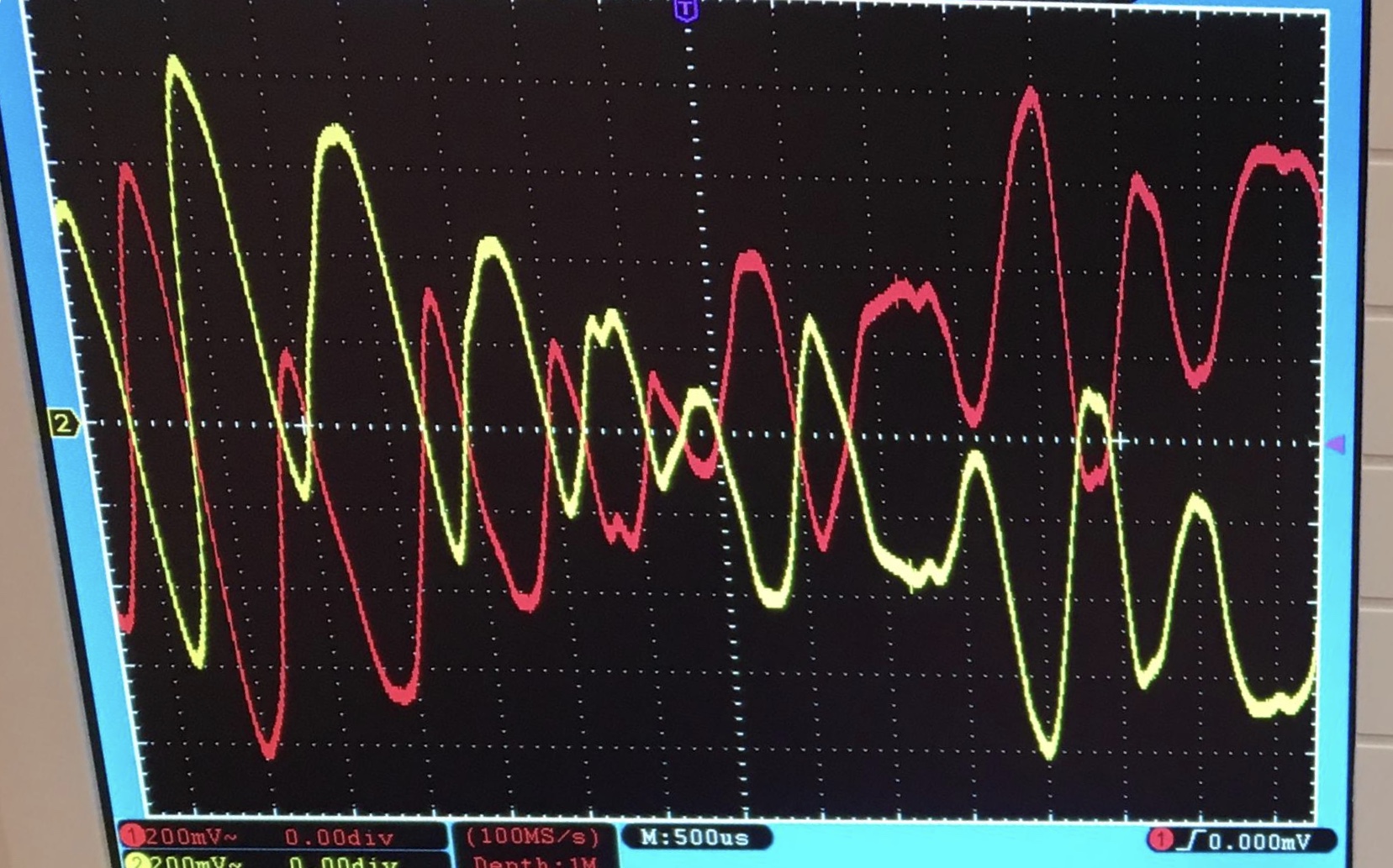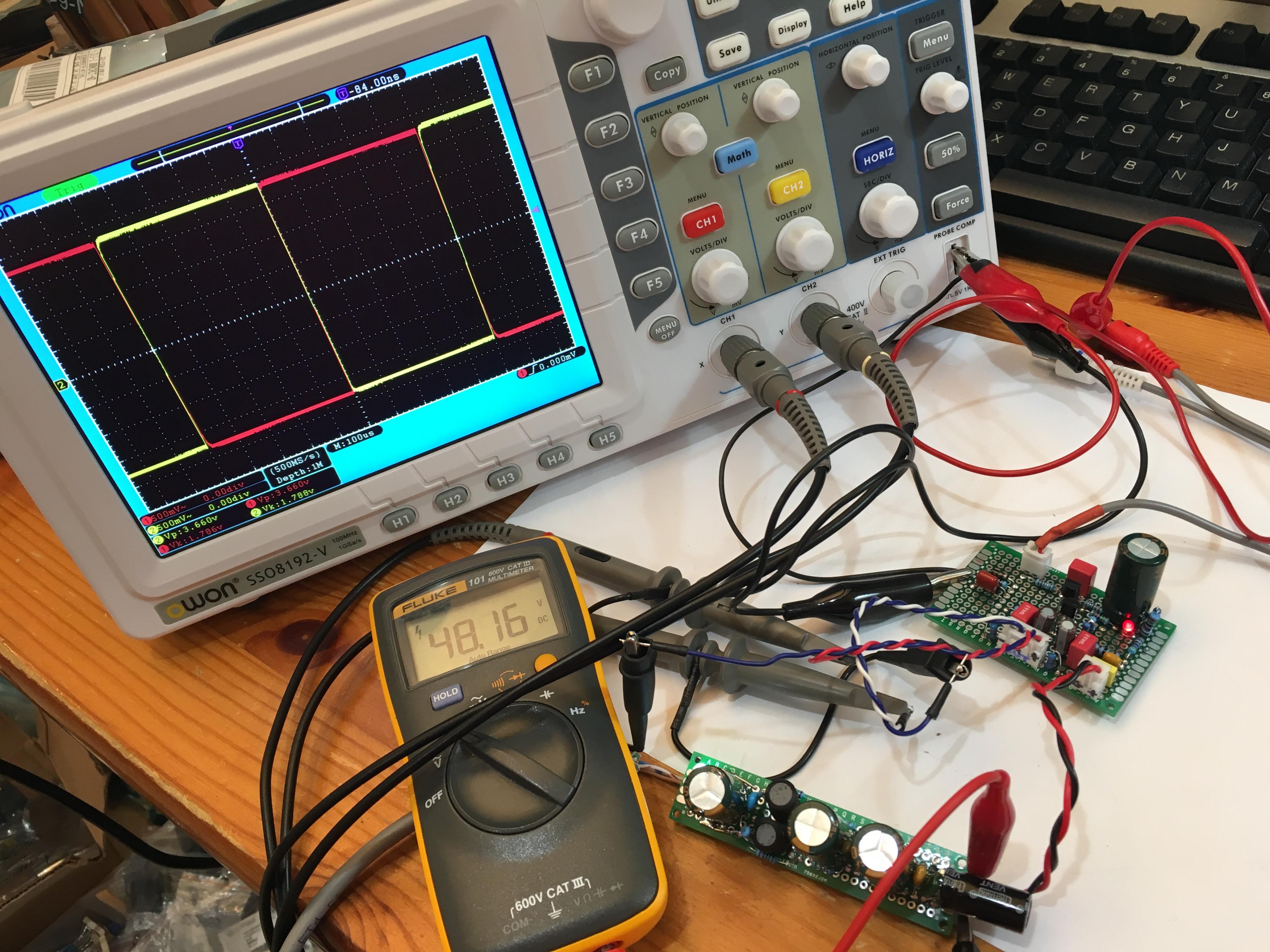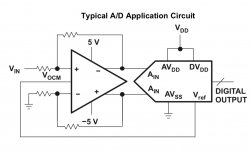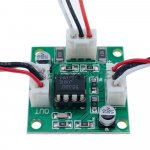Hi, maybe someone can give me some qualified advice.
I need symmetrical input signals for a stereo D-amp. Signal source is asymmetric.
Why a summetric signal input?
First, as it is preferred by the manufacturer, he advises to use input buffers and
second, to run one channel inverted to prevent the amp from bus pumping.
I have small, inexpensive stereo pre-amp boards with a NE5532 OP-amp, unity gain, that are inverting.
I plan to place them directly at the RCA input.
Now, my question:
Is there any problem if I run the input signal into one of the pre-amps inputs, inverting it, so I get the negative phase which feeds the D-amp.
Then take the inverted signal and run it into the second channel of the pre-amp, inverting it again, for the positve phase.
As far as I can see, there is no disadvantage and buffering and phase split are done with a minimum of OP-amp stages. The D-amp has 8k ohm input impedance.
I ask because I have not seen such a simple solution so far.
I need symmetrical input signals for a stereo D-amp. Signal source is asymmetric.
Why a summetric signal input?
First, as it is preferred by the manufacturer, he advises to use input buffers and
second, to run one channel inverted to prevent the amp from bus pumping.
I have small, inexpensive stereo pre-amp boards with a NE5532 OP-amp, unity gain, that are inverting.
I plan to place them directly at the RCA input.
Now, my question:
Is there any problem if I run the input signal into one of the pre-amps inputs, inverting it, so I get the negative phase which feeds the D-amp.
Then take the inverted signal and run it into the second channel of the pre-amp, inverting it again, for the positve phase.
As far as I can see, there is no disadvantage and buffering and phase split are done with a minimum of OP-amp stages. The D-amp has 8k ohm input impedance.
I ask because I have not seen such a simple solution so far.
Try this - it works well and sounds great. Gives the amp a nice SE Class A sound signature too. Not a bad thing for many Class D amps. Very simple.
Making balanced output from single end
I have even used it as a headphone amp here:
Balanced Drive 2 Transistor SE Class A Headphone Amp
Here is an example of the balanced output from single input:

Same for square wave:

There is the 2 transistor implantation, above scope shots were done with BC550 and BC560. The headphone amp used KSC1845 and 2SA1837.
Aksa even has a 3 transistor version with lower distortion if that matters to you.

Making balanced output from single end
I have even used it as a headphone amp here:
Balanced Drive 2 Transistor SE Class A Headphone Amp
Here is an example of the balanced output from single input:
Same for square wave:
There is the 2 transistor implantation, above scope shots were done with BC550 and BC560. The headphone amp used KSC1845 and 2SA1837.
Aksa even has a 3 transistor version with lower distortion if that matters to you.
I have small, inexpensive stereo pre-amp boards with a NE5532 OP-amp, unity gain, that are inverting.
Yes, as long as those preamp are indeed unity gain, it should work without problems and a 8K load is no big deal for ne5532.
Just another point of attention to look for: if you have a HF filter on these boards which is close to the audio band, you might want to remove it in the second channel.
If you want existing then tough to beat THAT1646.
Ready to use breakout board with bypass caps etc here:
BOB-14003 SparkFun | Mouser
Ready to use breakout board with bypass caps etc here:
BOB-14003 SparkFun | Mouser
Now, my question:
Is there any problem if I run the input signal into one of the pre-amps inputs, inverting it, so I get the negative phase which feeds the D-amp.
Then take the inverted signal and run it into the second channel of the pre-amp, inverting it again, for the positve phase.
As far as I can see, there is no disadvantage and buffering and phase split are done with a minimum of OP-amp stages. The D-amp has 8k ohm input impedance.
Not a good solution.
Use fully-differential THS4131 wired like this:

This will correctly rejects CM signal from the input and feeds your amp with a true symmetrical signal.
Interesting. Do I get this right: input --> 10k --> 100k going off to what appears to be power ground for no good reason ---> 100k || C_ceramic between -in and out?Just for clarification, this is the amp module, it is so small it can be soldered directly at the RCA
Do check which grounds (if any) are connected on the board in order to avoid any nasty surprises. With some bad luck the scalpel might have something to do. I would not want my signal ground and power ground to be connected, for one.
What you want is quite doable, it's basically Fig. 1 in Balanced I/O with an inverting input. Depending on levels required and the source's driving capabilities it may be a good idea to go lower than 10k for resistors, for a reduced noise penalty (at around 1 Vrms, I see little problem with 4k7 or 3k3 when using a genuine 5532).
Note that the circuit effectively has 6 dB of gain - if the source already outputs more than enough level and its noise becomes a potential issue, increase input resistor to achieve negative gain as needed. That's the advantage of having an inverting input.
Yes, you are right, the layout and picture are quite confusing, and do not make sense on first sight. I did not have the time to do a schematic, but will do. The C should buffer the +- voltage supply, the whole buffer is DC coupled.
The NE5532 (a real one!) has to drive 8k inputs, the gain is OK. It has to drive an ICEpower 250A amp that needs such a buffer.
It has to be changed to unity gain, it is x10 right now. At 1.60€ it is impossible to get a cheaper solution and the size makes it perfect to be soldered directly at the RCA input.
As I have to get 8 symmetric input buffer price is a factor. There are other, larger solutions out there, but none of them is a real good design.
With this tiny board only two resistors have to be changed and one input connected to another.
I´m just asking here, as I have never seen such a simple solution for converting an asymmetric signal to symmetric. Sure I will do some serious testing before using it in the final installation and use a real NE5532. Seems to be a really good OP-amp. I wander what the Chinese put into their fake chips. They sound cruel, this is no voodo, but easy to hear. Even the old TL072 did a better job.
The NE5532 (a real one!) has to drive 8k inputs, the gain is OK. It has to drive an ICEpower 250A amp that needs such a buffer.
It has to be changed to unity gain, it is x10 right now. At 1.60€ it is impossible to get a cheaper solution and the size makes it perfect to be soldered directly at the RCA input.
As I have to get 8 symmetric input buffer price is a factor. There are other, larger solutions out there, but none of them is a real good design.
With this tiny board only two resistors have to be changed and one input connected to another.
I´m just asking here, as I have never seen such a simple solution for converting an asymmetric signal to symmetric. Sure I will do some serious testing before using it in the final installation and use a real NE5532. Seems to be a really good OP-amp. I wander what the Chinese put into their fake chips. They sound cruel, this is no voodo, but easy to hear. Even the old TL072 did a better job.
Last edited:
If it even is an opamp (rather than, say, a comparator), I'd be guessing LM358 - they are ubiquitous general purpose dual opamps, super cheap when bought in bulk and will sustain +/-15 V. (The trusty NJM4558 can be similarly inexpensive but isn't as common. You bet counterfeiters would be looking for liquidations of old stock for maximum profit margin.) Their crossover distortion tends to be plainly obvious on a scope, it's that bad. Add a resistor from output to V-, about 10k, maybe 4k7 or 3k3 - if it sounds OK then, that's a dead giveaway.I wander what the Chinese put into their fake chips. They sound cruel, this is no voodo, but easy to hear. Even the old TL072 did a better job.
- Status
- This old topic is closed. If you want to reopen this topic, contact a moderator using the "Report Post" button.
- Home
- Source & Line
- Analog Line Level
- Simple asym to symmetic buffer
